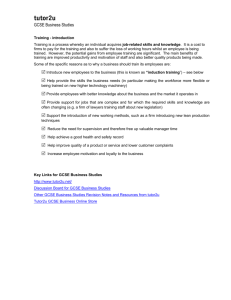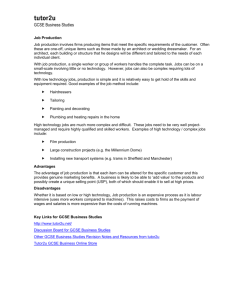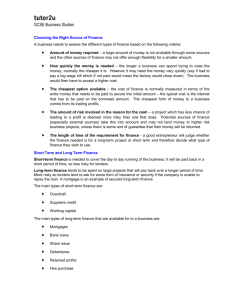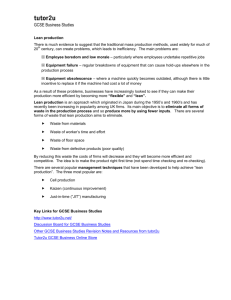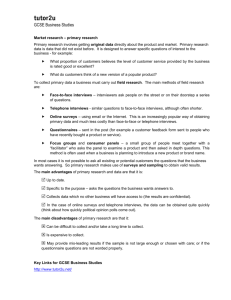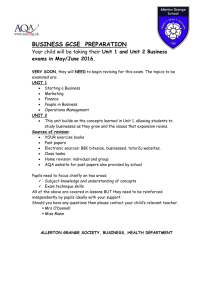Marketing Mix & Objectives
advertisement
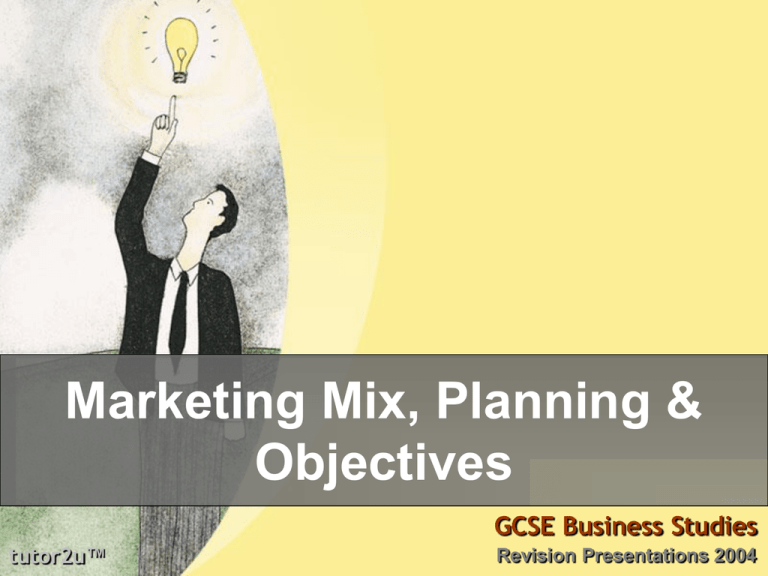
Marketing Mix, Planning & Objectives GCSE Business Studies tutor2u™ Revision Presentations 2004 Marketing Mix - Introduction Marketing Mix Product Price Place Promotion Often referred to as the “Four P’s of Marketing tutor2u™ GCSE Business Studies Product Can be both A tangible good (e.g. iPod media player) A service (e.g. cinema) Product is something that satisfies customer needs and wants Many products try to develop an associated brand – a name, design, sign or symbol that helps it to be differentiated from competitor products Products rarely last for ever – they have a “life cycle” Businesses need to think carefully about new product development if they are to remain competitive tutor2u™ GCSE Business Studies Price Price – the value a customer is prepared to pay in exchange for taking ownership of a product, or receiving a service Price directly affects revenue Revenue = number of units sold x price But how much a customer buys (“demand”) is also affected by price So an increase in price doesn’t always mean an increase in revenue Various methods of setting a price Pricing strategy is important Products need to be “competitive” Price needs to be consistent with the overall objectives of the business tutor2u™ GCSE Business Studies Place Not really a “P” – since Place is all about distribution Channels of distribution – the method by which goods or services are transferred from producers to consumers In most markets there are several distribution channels E.g. wholesalers, agents, retailers Business may use one or more channels Direct selling (i.e. from producer direct to consumer) is an increasingly popular method of distribution E-commerce (selling via the Internet) is another kind of distribution channel tutor2u™ GCSE Business Studies Promotion Covers all the different ways a business can communicate with its customers; e.g. Personal selling Direct marketing Advertising Sales promotion Public relations Sponsorship tutor2u™ GCSE Business Studies Marketing Planning Marketing planning – all about deciding what the marketing objectives are – and coming up with a way of achieving them! Main steps Do an annual audit to establish “where we are” by gathering data through market research etc Set SMART marketing objectives Create and evaluate alternative strategies to deliver objectives Implement strategy by changing the marketing mix i.e. day to day tactics Evaluate the success of marketing activities in meeting set objectives before the next annual audit tutor2u™ GCSE Business Studies Marketing Audit A marketing plan is usually prepared following a review of the current situation (sometimes called a “marketing audit”) that looks at questions such as: What are our existing products and brands? Are the markets we do business in growing? If so, how fast? Who are our competitors? What advantages (if any) do we have over them? How effective has our marketing been in recent history? Are there ways in which we could achieve the marketing objectives differently and more profitably? tutor2u™ GCSE Business Studies What are Marketing Objectives? Marketing objectives are the expected outcomes a business is trying to attain through its marketing activities at the end of a given time period Ideally - marketing objectives must be SMART (see next slide) Marketing objectives need to be in line with the other objectives for the business Marketing objectives can be used as a way of measuring performance over time tutor2u™ GCSE Business Studies SMART Marketing Objectives Ideally, marketing objectives need to be SMART S = Specific: i.e. state what the firm is seeking to achieve e.g. increase sales M = Measurable i.e. set in terms of a number value e.g. achieve sales of £1m or increase market share to 15% etc A = Achievable i.e. the target can be met within the resources of the firm R = Realistic the target must be achievable in terms of financial and human resources available. T = Time bound i.e. within a given period of time e.g. 12 months tutor2u™ GCSE Business Studies Marketing Strategies Business Strategy Example Marketing Strategies Grow sales Launch new products Expand distribution (e.g. open more shops) Start selling products into overseas markets Increase profits Increase selling prices Reduce the amount spent on television advertising Build customer awareness tutor2u™ Implement a public relations programme Invest more in advertising GCSE Business Studies
